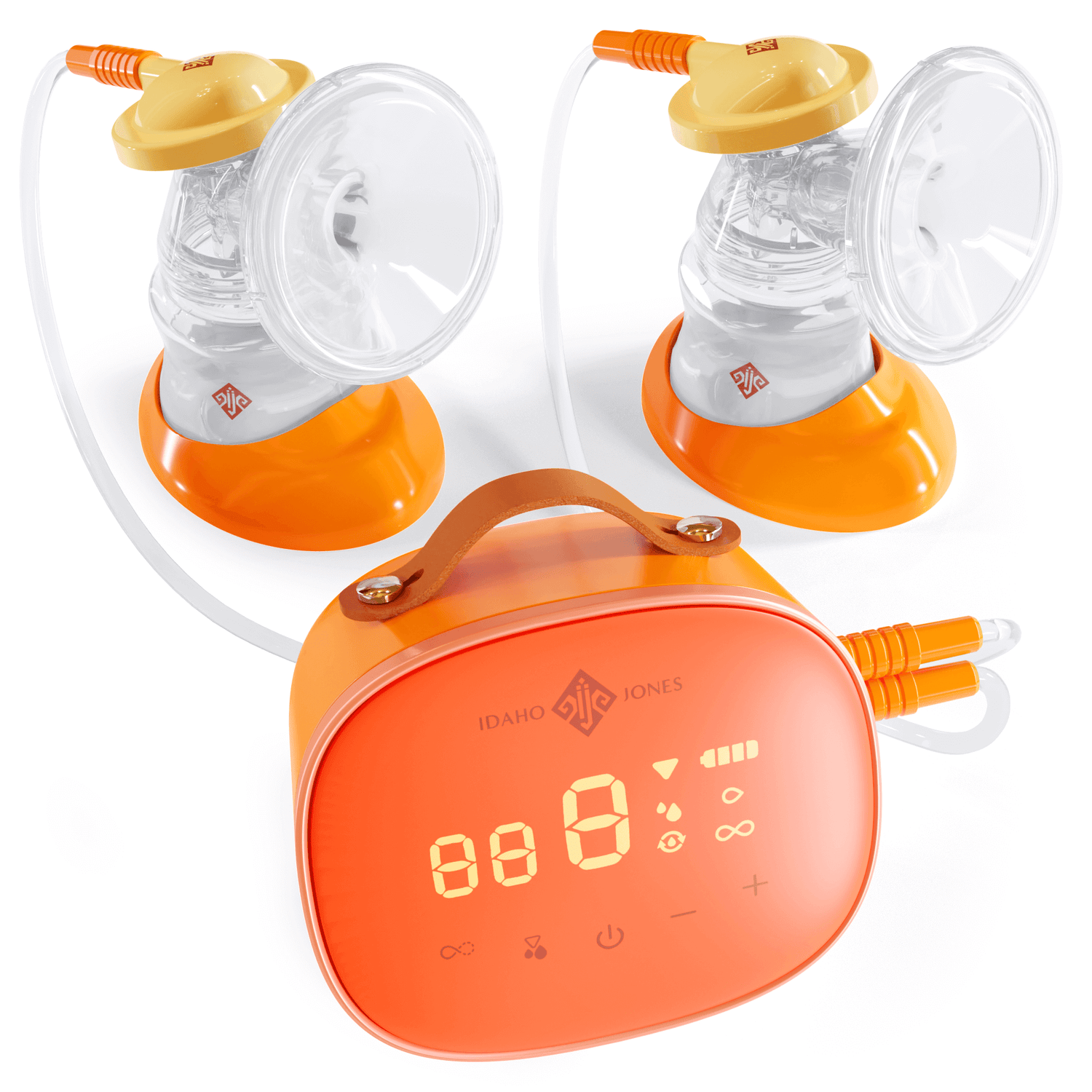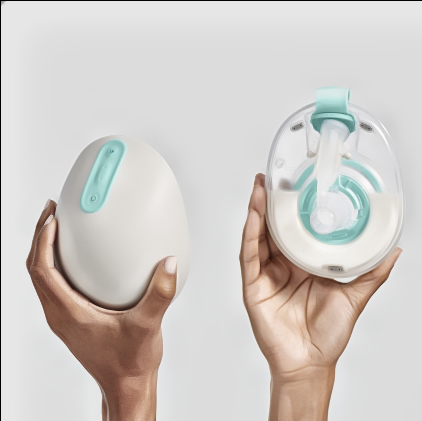If you’re a pumping mom, chances are you’ve seen, heard of, used—or at least wished for something like—the wearable Willow breast pump. This “smart” pump is now on its third generation model, and is meant to give mobility and convenience to the process of pumping your milk. This post contains an overview of how the pump works, how to care for your Willow pump, and tips and tricks from the Willow company as well as users who’ve shared their experience on the internet. Instead of getting stuck wading through Willow pump reviews, start here to gain an understanding of what moms think of this hands-free pump.
What are the Willow Pump Parts?
When you buy a Willow, you get two pumps (one for each breast), two flanges (come in 21, 24, or 27 mm sizes), two flex tubes (the piece that carries the milk from the flange to the bag or container), two cleaning brushes, a charger, and 24 four ounce milk collection bags. The milk collection container is a reusable solution that you can use with the pump instead of the disposable milk bags. The milk container insert serves as the flange when you’re using the containers to pump, and is available in the same sizes as the flanges (21, 24, and 27 mm).
The parts of the Willow that you will need to clean are the flex tubes, the flanges, and the containers (if you use them). You can wash these parts in the dishwasher or boil them. See this post from the company for more in-depth instructions. Willow recommends a regular deep clean of these parts to keep your pump in good condition and functioning properly.
How to Use the Willow Pump
This intro video from Willow goes over getting your pump ready for use. When setting up for your first session, you’ll clean the container and flange, download the Willow app (available for iPhone and Android), “wake up” the pump by plugging it into the charger. The Willow app contains videos to help you get started and master the pump’s learning curve.
In an individual pumping session (demonstrated in this video from Willow), you first press and hold the power button until the Willow lights up. Then, once you’ve aligned the pump to your nipple and brought it firmly to your chest, press the play button to start the pump. The Willow will start a session with slow gulping motions, and then transition to shorter, quicker gulps in stimulation mode. This mimics your baby’s behavior at the breast to send signals to your brain to release milk. The pump will switch to expression mode when it senses letdown, which sounds and feels quieter and slower. If your pump doesn’t transition to expression mode within five minutes, check the pump seal and position. If you’re not sure what mode the pump is in, you can check in the app.
You can change the pump’s suction on the app or on the pump itself using the +/- buttons. Every generation of the Willow has 7 suction settings, though there is slight variance in the most recent model (Generation 3). The suction levels available depend on whether you’re in stimulation or expression mode.
The pump session will end one of three ways: either because the Willow stops automatically after 25 minutes (signaled by a pulsing white light), stops because the milk bag is full (signaled by a solid white light), or because you choose to stop a session with the pause button. When you finish a session, you have to “flip to finish,” tilting the pump in a particular way so that all of the milk gets into the bag or container and doesn’t spill.
Troubleshooting, Tips, & Tricks
As the Willow has been through three generations so far, there have been a variety of issues with the pump. Some have been resolved by the company’s updates and others have been “hacked” or addressed by pump users themselves. If you do decide to get a Willow, the company has extensive customer support and seems generally willing to help you troubleshoot issues. Some common issues that users face—often documented in Willow breast pump reviews—include:
- Problem: Sometimes the Willow app doesn’t accurately measure the amount of milk pumped.
- Solution: This can happen if you don’t have a good seal and the pump lets air into the bag. It will likely improve as you get better at using the pump. You can also use the bag on the outside of the pump (shown here) so that you can see the amount pumped rather than relying on the app.
- Problem: The pump can separate, with the back popping off as the bag fills with milk.
- Solution: Some users have found a way around this by leaving the bag on the outside of the pump.
- Problem: Mothers find that they get less milk with the Willow than with a conventional electric pump.
- Solution: Some users find that using the pump sideways can help remove more milk in a session. Issues with seal and positioning can also cause less milk removal in a session.
- Problem: Since the Willow flanges only come in three sizes, some people have trouble finding a comfortable flange fit.
- Solution: Some pumping moms use cushions, such as the BeauGen breast pump cushions to create a tighter, more comfortable flange fit.
How Much Does the Willow Pump Cost and Can I Get It Through My Insurance?
The third generation Willow pump retails for $499.99. Typically the Willow is not one of the pumps fully covered by your insurance, but some moms have luck submitting their receipt for full or partial reimbursement from their insurance company. Curious if your insurance will cover the Willow pump? Contact a representative from your insurance company and ask about coverage or reimbursement.
Several medical supply companies carry the Willow and that may make insurance coverage or reimbursement more likely than purchasing your pump from the company directly. The following durable medical equipment (DME) providers distribute the Willow pump and accessories: BreastPumps.com, Aeroflow, and 1 Natural Way. You can reach out to these companies directly and inquire about your specific insurance plan and company.
You can also use an HSA/FSA card to pay for your Willow pump. You can pay with your HSA/FSA debit card when buying a pump from the Willow site, or purchase with another credit or debit card and submit receipts for reimbursement.
The Willow company has also partnered with another company to offer payment plans on the pump, so you can use that option at checkout to pay for your pump over time.
Another expense of the Willow pump are the bags (costing between $0.50 and $1/bag, which adds up since you need two bags per pump session and are likely pumping multiple times each day). Reusing your Willow bags is a way to cut costs as you use this hands free pump. If you choose to reuse bags, it’s recommended to not use the same bag for more than 24 hours and to refrigerate the bags between uses. There are a number of YouTube tutorials on reusing the Willow bags—like this one from Mommy Shark Uncensored and this video from Amy Elliot.
---
The Willow pump offers a hands-free option for exclusive and frequent pumpers that allows you to keep up with your pumping schedule while still maintaining the freedom to work, get through a Zoom call or face-to-face meeting, play with your kid(s), or even lay down for some rest. Though the pump does have some issues, the company seems dedicated to improvement and customer service, and there are many resources created by pumping moms to help you learn how to use the Willow and decide if it’s right for you.



